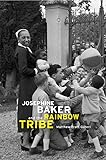Josephine Baker and the Rainbow Tribe / Matthew Pratt Guterl.
Material type: TextPublisher: Cambridge, MA : Harvard University Press, [2014]Copyright date: ©2014Description: 1 online resource (286 p.) : 30 halftonesContent type:
TextPublisher: Cambridge, MA : Harvard University Press, [2014]Copyright date: ©2014Description: 1 online resource (286 p.) : 30 halftonesContent type: - 9780674047556
- 9780674369962
- 792.8092
- GV1785.B3
- online - DeGruyter
- Issued also in print.
| Item type | Current library | Call number | URL | Status | Notes | Barcode | |
|---|---|---|---|---|---|---|---|
 eBook
eBook
|
Biblioteca "Angelicum" Pont. Univ. S.Tommaso d'Aquino Nuvola online | online - DeGruyter (Browse shelf(Opens below)) | Online access | Not for loan (Accesso limitato) | Accesso per gli utenti autorizzati / Access for authorized users | (dgr)9780674369962 |
Browsing Biblioteca "Angelicum" Pont. Univ. S.Tommaso d'Aquino shelves, Shelving location: Nuvola online Close shelf browser (Hides shelf browser)

|

|

|

|

|

|

|
||
| online - DeGruyter Global Health Law / | online - DeGruyter Immigration Economics / | online - DeGruyter Inferno : An Anatomy of American Punishment / | online - DeGruyter Josephine Baker and the Rainbow Tribe / | online - DeGruyter Latino Pentecostals in America : Faith and Politics in Action / | online - DeGruyter The Intellectual Life of Edmund Burke : From the Sublime and Beautiful to American Independence / | online - DeGruyter The Land of the Elephant Kings : Space, Territory, and Ideology in the Seleucid Empire / |
Frontmatter -- Contents -- Prologue -- 1. Too Busy to Die -- 2. No More Bananas -- 3. Citizen of the World -- 4. Southern Muse -- 5. Ambitious Assemblages -- 6. French Disney -- 7. Mother of a Wounded World -- 8. Unraveling Plots -- 9. Rainbow's End -- Epilogue -- Abbreviations -- Notes -- Acknowledgments -- Index
restricted access online access with authorization star
http://purl.org/coar/access_right/c_16ec
Creating a sensation with her risqué nightclub act and strolls down the Champs Elysées, pet cheetah in tow, Josephine Baker lives on in popular memory as the banana-skirted siren of Jazz Age Paris. In Josephine Baker and the Rainbow Tribe, Matthew Pratt Guterl brings out a little known side of the celebrated personality, showing how her ambitions of later years were even more daring and subversive than the youthful exploits that made her the first African American superstar. Her performing days numbered, Baker settled down in a sixteenth-century chateau she named Les Milandes, in the south of France. Then, in 1953, she did something completely unexpected and, in the context of racially sensitive times, outrageous. Adopting twelve children from around the globe, she transformed her estate into a theme park, complete with rides, hotels, a collective farm, and singing and dancing. The main attraction was her Rainbow Tribe, the family of the future, which showcased children of all skin colors, nations, and religions living together in harmony. Les Milandes attracted an adoring public eager to spend money on a utopian vision, and to worship at the feet of Josephine, mother of the world. Alerting readers to some of the contradictions at the heart of the Rainbow Tribe project--its undertow of child exploitation and megalomania in particular--Guterl concludes that Baker was a serious and determined activist who believed she could make a positive difference by creating a family out of the troublesome material of race.
Issued also in print.
Mode of access: Internet via World Wide Web.
In English.
Description based on online resource; title from PDF title page (publisher's Web site, viewed 30. Aug 2021)


